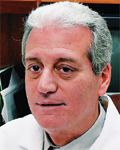- Acne
- Actinic Keratosis
- Aesthetics
- Alopecia
- Atopic Dermatitis
- Buy-and-Bill
- COVID-19
- Case-Based Roundtable
- Chronic Hand Eczema
- Chronic Spontaneous Urticaria
- Drug Watch
- Eczema
- General Dermatology
- Hidradenitis Suppurativa
- Melasma
- NP and PA
- Pediatric Dermatology
- Pigmentary Disorders
- Practice Management
- Precision Medicine and Biologics
- Prurigo Nodularis
- Psoriasis
- Psoriatic Arthritis
- Rare Disease
- Rosacea
- Skin Cancer
- Vitiligo
- Wound Care
Article
Pearls for facial wound reconstruction
National report — Reconstruction of facial wounds is excisional surgery that requires special attention to cosmetic outcome.

"Excisional surgery on the face is no different from surgery on other body areas, but more careful planning of wound orientation and reconstruction is necessary to create the optimal scar and to avoid altering the eyes, nose or mouth," says Michael S. Lehrer, M.D., a Mohs surgeon in private practice near Philadelphia and a clinical assistant professor at the Hospital of the University of Pennsylvania.
Dr. Lehrer and Anthony V. Benedetto, D.O., presented a session on facial wound reconstruction at the an American Academy of Dermatology meeting. Dr. Benedetto is an associate professor of dermatology at the Johns Hopkins University School of Medicine, Baltimore.

"For a better cosmetic outcome, avoid removing more fat from the center of the ellipse than from the apices, and stay in a uniform plane throughout the excision," Dr. Benedetto says.
An elliptical or fusiform incision is typically made perpendicular to the skin surface, unless the skin has terminal hairs. In that case, it is important to angle the incision parallel to the hair follicles, to avoid transecting them, Dr. Benedetto advises.
Standing cones
In some cases, a shorter incision is made because of the location of the wound or the mobility or texture of the skin. However, a shorter ellipse, with a length-to-width ratio of less than three, can lead to standing cones or "dog-ears" at the end of the incision. Standing cones are portions of excess skin that remain at the ends of a suture line following the repair.
One method to reduce standing cones involves lifting the excess "pouch of skin" at the end of the incision and making an incision at the base on each side of the excess skin to remove a triangular-shaped section, known as a Burow's triangle. Sutures then close the wound by continuing along the line of the incision.
Alternatively, M-plasty or T-plasty can be used to shorten the fusiform excision and reduce dog-ears. The scar lines should be placed within natural creases of the skin. To minimize the deformity, the scar should be kept short and in the direction of the natural skin lines.
Closing the wound
Primary factors affecting the type of stitches used include the thickness and quality of the skin and the amount of tension created during the closure, according to Dr. Lehrer. Suturing techniques include the simple interrupted stitch, the leveling stitch, running and running subcuticular stitches, buried stitches, vertical and horizontal mattress stitches, the "far-near, near-far" or pulley or winch stitch, the three-point tip stitch and the four-point stitch.
Of these, the most widely used in cutaneous surgery is the simple interrupted stitch. To evert the wound edges, the suture should follow a flask-shaped path, and the knot should be moved off the incision line. Another common stitch, the leveling stitch, is a type of simple interrupted stitch used to align wound edges of different height. The stitch takes a deeper "bite" on the lower side of the wound. Other stitches are designed for specific purposes or skin conditions.
Wounds of unequal length should be closed according to the Rule of Halves.
Newsletter
Like what you’re reading? Subscribe to Dermatology Times for weekly updates on therapies, innovations, and real-world practice tips.











